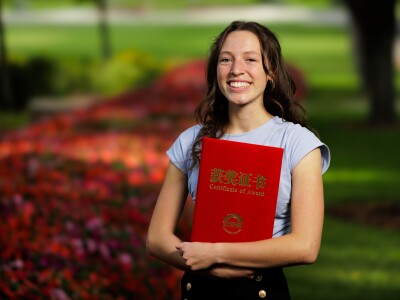Workers are exposed to dangerous levels of fine-particle pollution; average PM2.5 concentration is 8x WHO's air quality guidelines.
With each breath, brick workers in Nepal’s Kathmandu Valley inhale dangerous particulates. From hazardous aerosols released during the brickmaking process and indoor cooking to emissions from vehicles and factories that seep into their homes, air pollution in the region is inescapable.
Concerned about the effects of these exposures, an interdisciplinary BYU team recently came together to conduct a research study in Nepal, aiming to measure brick workers’ exposure to pollutants and to assess their respiratory health. The eventual goal is to determine what information, technology and strategies they can develop with the Nepali people to help them improve their well-being.
“The people here are just the humblest, kindest, most welcoming people I’ve ever associated with,” said BYU public health professor Jim Johnston, who led the group of more than two dozen researchers. But, he added, air pollution “lives with them every day, at the brick kiln, when they’re awake, when they’re asleep, when they’re working, when they’re home.”
The researchers were particularly concerned by brick workers’ exposure to PM2.5, particulate matter less than 2.5 micrometers in diameter, small enough to bypass the respiratory system’s defenses and get into the gas-exchange region of the lungs. The team also wanted to determine workers’ exposure to silica dust, another respiratory hazard, at the brick kilns. Brickmaking is central to the economy and culture of Nepal — many workers not only spend all day at the kiln, they also build their homes out of the bricks and live onsite at the factory during the brickmaking season, often with their families.

Additional exposure to indoor air pollution and traffic emissions, as well as poor sanitation and diet, makes the brick workers and their families especially vulnerable to respiratory illnesses like chronic obstructive pulmonary disease.
“A lot of people here don’t even know that the conditions they work in are so harmful to their health,” said BYU public health student James Lu. “They think it’s normal to be breathing in high levels of silica and dust. So this research can help us educate people and make a difference in their lives.”
“I’m enthusiastic and very happy to work with BYU,” added Seshananda Sanjel, a professor at the Karnali Academy of Health Sciences in Nepal. “The Nepali government doesn’t have the funding [we need] for research, [so] with this collaboration we can do many more things, and I expect this collaboration will go for many years.”
The group’s initial analysis of the data they collected has already yielded useful information, published in the journal Atmosphere. Twenty-four-hour monitoring found the workers are exposed almost constantly to dangerous levels of PM2.5, even when at home, and that the average PM2.5 concentration across all the workers was about eight times the World Health Organization’s air quality guidelines. Forthcoming papers also describe differences the group found in silica exposure and inflammation among workers in five job categories at the brick kiln. Workers who removed dirt from the top of the kiln after the bricks were fired had substantially higher silica exposures than other workers.
To get the information they needed, the BYU group drew from their many areas of expertise, as well as that of their collaborators from the University of Utah, Kathmandu University and the Karnali Academy of Health Sciences, and local Nepali leadership.
BYU faculty and students in nutrition, dietetics and food sciences performed health assessments for the 50 or so brick workers that participated in the study, examining their vitals, diet and lung function. The nursing team collected saliva and blood samples and used a novel method of pulmonary ultrasound to look for evidence of inflammation in the lungs.
To get information about each worker’s exposure to PM2.5 and silica-containing dust as they moved throughout the day — previous research has used only stationary monitoring of an area — the public health group fitted the workers with air pollution monitors they wore for 24 hours.
Cell biologists in the group analyzed blood serum to determine how PM2.5 and silica exposures impacted inflammatory responses among the workers. Meanwhile, BYU engineers took a zoomed-out approach and assessed community development challenges, looking at infrastructure, housing, farming practices, community leadership structures and the quality of water, soil and air in the region.
“We all have a common goal, and our unique ways of learning are creating this big-picture effect,” said nursing student Symbria Lewis.
“Early impressions of the data we’ve collected suggest that any kind of solution or intervention has to be mated with Nepali culture and the way that they operate,” said BYU engineering professor Andrew South. “The temptation is to observe a problem and prescribe a solution, but it’s so important to understand the full context of the problem so that the solution is sustainable.”
BYU faculty and students anticipate future trips to Nepal to continue the research, which promises to be beneficial for BYU as well as the Nepali people.
“I don’t know that I’ve ever seen my students so happy and so engaged in learning,” Johnston said. “It’s been incredibly rewarding to just sit back and listen to them talk about the experiences they’re having here, their love for the people, their desire to use the science to make the world a better place. It’s like the lights have come on.”



